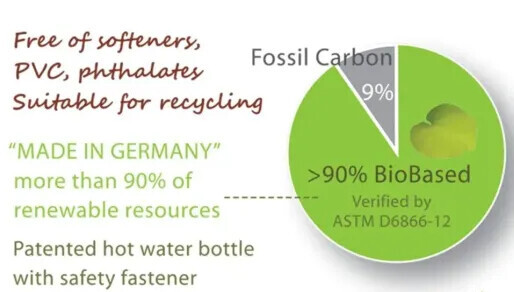When colder weather settles in, hot water bottles become a go-to comfort for many people. They’re perfect for warming up your bed, relaxing tired muscles, or having something snug to hold on brisk nights. For a long time, traditional rubber hot water bottles were found in almost every home. Recently, however, eco hot water bottles have been catching on fast. If you’re curious about what’s prompting so many people to make the change, keep reading as I break down how eco hot water bottles work, how they compare to the old-school variety, and the special perks they bring.

Why People Are Rethinking Hot Water Bottles
Hot water bottles have earned their place as a household basic, helping folks relax and relieve aches quickly. Rubber bottles are familiar – you know what to expect, and they do their job well. But now, more people are aware of how everyday basics impact the environment and personal health. Concerns about sustainability and safer materials have led people to check out alternatives, as companies introduce eco-friendly choices that still deliver warmth and reliability.
Eco hot water bottles go beyond simply keeping you warm. They shrink your carbon footprint, often use healthier ingredients, and sometimes last even longer. As green living gets more popular, these bottles are showing up in specialty boutiques as well as on major shopping sites. Understanding what makes them stand out is key when you’re shopping for your next hot water bottle.
Eco Hot Water Bottles vs. Traditional Rubber Ones
Eco hot water bottles come in several sizes and shapes, but it’s what they’re made of that sets them apart. Here’s how the two types match up:
- Materials Used: Basic rubber bottles are made from latex sourced from rubber trees, often with added chemicals. Ecofriendly bottles use natural compounds like thermoplastic elastomers, biodegradable plant starch, or sometimes plain organic rubber free from lots of additives.
- Lifecycle and Disposal: Traditional rubber lingers in landfills for years and takes a very long time to decompose. Many eco bottles are compostable or recyclable, or at least made to break down much faster.
- Sensitivity: Latex in rubber bottles bothers some people with allergies. Eco bottles use latexfree ingredients like bioplastics or thermoplastics, making them a safer pick for sensitive users.
- Designs and Features: Both types can sport cute covers, quirky forms, and reliable caps. Eco bottles can sometimes withstand hotter water and don’t age as quickly, thanks to materials that resist splitting or hardening over time.
Eye-catching Features That Make Eco Bottles Stand Out
Eco hot water bottles have made their way into the spotlight for several reasons. Here are features that make them more than just another option:
- Biodegradable or Recyclable Materials: Many eco bottles use compounds that fall apart easily when disposed, tackling landfill problems head-on.
- No Chemical Smells: If you dislike the odor traditional bottles sometimes give off, eco models made from plant-based blends or top-quality plastics keep things fresh and odorless.
- Allergy-friendly Choices: For those who need to be careful about allergies, ingredient lists on eco bottles are often clear and detailed.
- Durability: Plenty of eco bottles hold up just as well – or sometimes even better – than rubber ones, since they often don’t get brittle so quickly.
- Perfect for Gifting: With creative designs, soft covers, and vibrant prints, eco hot water bottles serve as thoughtful, practical presents for people of all ages.
Eco bottles also grab attention because they’re made with care, and many come with packaging made from recycled or minimal materials – something that appeals to anyone wanting to go a bit greener.
Getting Started With Eco Hot Water Bottles
If you’re making the switch, the process is simple. Here are a few tips to kick things off with your new ecofriendly bottle:
- Pick a Trustworthy Brand: Go for brands that clearly state their ingredients and commit to safety. Look for reassuring tags like BPAfree, compostable, or certified organic.
- Figure Out the Right Size: Most bottles contain 1 to 2 litres, but a smaller version is perfect for travel or little kids.
- Inspect the Cap: A solid cap makes all the difference. Make sure it tightens nicely and won’t let out any leaks – especially at bedtime!
- Always Use a Cover: Even with soft, ecofriendly materials, a nice cloth cover keeps your skin protected and adds comfort.
- Easy Cleaning: Dry the bottle thoroughly after each use and give it a gentle wipe. Avoid harsh chemicals or bleaches – eco bottles like it gentle.
What To Watch For When Buying
Switching over to eco hot water bottles means you might spot some differences in how they function. Here’s what to look out for and how to get the most from your eco bottle:
- Temperature Tolerance: While quality eco bottles can hang on to heat well, some softer plastics don’t like boiling water. Stay on the safe side and check the recommended temperature before filling.
- Flexibility vs. Sturdiness: Depending on the mixture used, some eco materials feel stiffer than rubber, while others feel softer. If you prefer to wrap your bottle around a limb or waist, look for one with the right texture – reviews can help.
- True Green Claims: Some brands might say “eco” but use vague language. Keep an eye out for real certifications or eco audits so you can buy with confidence.
- Cost Factor: Eco bottles can cost a bit more at first, but their durability and environmental benefits often make up for the higher tag in the long-term.
- Allergy Warnings: Always read labels closely if allergies are an issue, so you’re not swapping one allergy risk for another.
Safe Filling and Avoiding Overheating
Not every eco bottle can handle boiling water straight from the kettle. Quality options will include clear guides on safe filling temps. Some even feature built-in temperature indicators. To protect your bottle, try letting hot water cool for a minute before pouring it in. This helps extend the life of your bottle and avoids skin burns, too.
Comfort and Shape Variety
Check how a bottle feels in your hands or against sore joints. Bioplastics make it possible to create special shapes or textured surfaces that spread heat more evenly, which is a real relief for aches and pains.
Eco-minded Packaging
One bonus with most eco brands: less waste. Bottles often arrive in recycled or simple cardboard packaging, letting you cut back on single-use plastics and unnecessary extras.
Pro Tips for Getting the Best From Your Eco Hot Water Bottle
To really make your new eco bottle earn its place, try these handy ideas:
- Extend Warmth: Pop your eco bottle into a fleece pouch or wrap it in a towel to lock in heat for hours.
- Add Aromatherapy: Many eco bottles pair nicely with lavender or eucalyptus-scented covers, helping you relax and unwind before bed.
- Chill for Cold Relief: Your bottle isn’t just for heat. Fill with cold or ice water and use as a soft, reusable ice pack – ideal for warm days or after exercise.
- Kid and Senior Friendly: Safe, odourless materials make eco bottles a wise choice in homes with young kids or anyone sensitive to strong smells. The smoother surface can also be gentler against the skin.
With a little care – like not overfilling, keeping it dry between uses, and checking periodically for wear – your eco hot water bottle will serve you safely for years to come.
Common Uses and Everyday Upsides
Plenty of everyday moments show just how practical eco bottles can be. I’ve seen parents use them in cribs and stroller beds as a safer warming method without worry about leaks. Runners and gym lovers sometimes keep an eco bottle in the freezer for a non-chemical ice pack. Personally, the fact that there’s no rubbery smell means I’m happy using mine for cramps, achy shoulders, or chilly mornings at my desk. It’s remarkable what such an accessible item can do for your daily routine.
- Bed Warmers: Slip an eco bottle into your bed a few minutes before you climb in for instant coziness, all without a chemical odor.
- Pain Relief: Direct warmth on sore backs, stiff muscles, or even period pain is easy and comfortable.
- Outdoor Use: Eco bottles make perfect hand warmers at chilly picnics, on hikes, or around the campfire, and they leave less waste behind.
Frequently Asked Questions
Do eco hot water bottles work just as well as traditional rubber ones?
Absolutely. If you pick a bottle made from high-quality materials, it’ll hold and release heat comparably to a rubber bottle. Look at reviews and select a reputable brand for peace of mind.
How should I dispose of it at the end of its life?
Most eco bottles are designed to be composted or break down years faster than rubber. Always check the specific instructions provided on the packaging or by the manufacturer.
Will it smell odd or like chemicals?
No, the right eco bottle, made from pure natural or top-quality plastics, won’t have those off-putting smells rubber bottles sometimes do.
Switching to an eco hot water bottle is an easy way to cut down on waste, lower the risk of allergies, and support greener living every day. Whether you want cozy nights, safer pain relief, or just an all-around better bottle, these eco bottles blend comfort and sustainability – and make you feel good in more ways than one.
